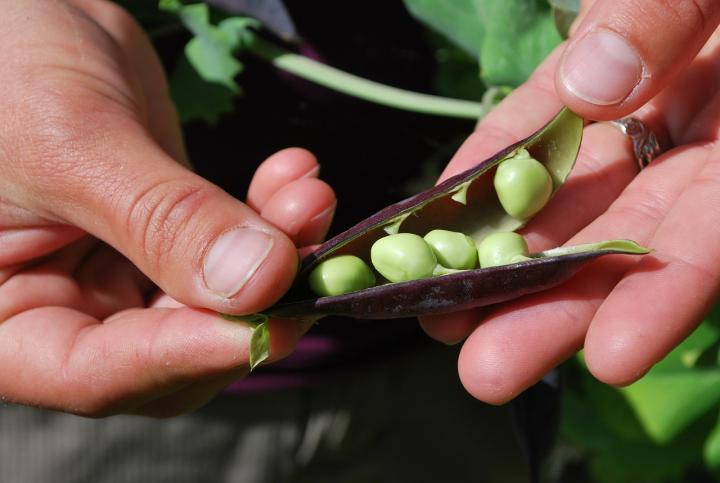
Peas are a cool-season crop, now coming in three separate varieties to suit your garden and cooking needs. They are: Pisum savitum, which includes both garden peas (sweet pea, inedible pod) and snow peas (edible flat pod with small peas inside) and Pisum macrocarpon, snap peas (edible pod with full-size peas). They are easy to grow, but with a very limited growing season. Furthermore, they do not stay fresh long after harvest, so enjoy them while you can!
Planting
- To get the best head start, turn over your pea planting beds in the fall, add manure to the soil, and mulch well.
- As with other legumes, pea roots will fix nitrogen in the soil, making it available for other plants.
- Peas will appreciate a good sprinkling of wood ashes to the soil before planting.
- Sow seeds outdoors 4 to 6 weeks before last spring frost, when soil temperatures reach 45 degrees F. See this blog for tips on when to start planting peas.
- Plant 1 inch deep (deeper if soil is dry) and 2 inches apart.
- Get them in the ground while the soil is still cool but do not have them sit too long in wet soil. It’s a delicate balance of proper timing and weather conditions. For soil that stays wet longer, invest in raised beds.
- A blanket of snow won’t hurt emerging pea plants, but several days with temperatures in the teens could. Be prepared to plant again.
- Peas are best grown in temperatures below 70 degrees F.
- Check out this video to learn how to plant peas early while soil is cold.
Care
- Make sure that you have well-drained, humus-rich soil.
- Poke in any seeds that wash out. (A chopstick is an ideal tool for this.)
- Be sure, too, that you don’t fertilize the soil too much. Peas are especially sensitive to too much nitrogen, but they may like a little bonemeal, for the phosphorus content.
- Though adding compost or manure to the soil won’t hurt, peas don’t need heavy doses of fertilizer. They like phosphorus and potassium.
- Water sparsely unless the plants are wilting. Do not let plants dry out, or no pods will be produced.
- For tall and vine varieties, establish poles or a trellis at time of planting. Look at this video to find out how!
- Do not hoe around plants to avoid disturbing fragile roots.
- It’s best to rotate pea crops every year or two to avoid a buildup of soil-borne diseases.
Pests/Diseases
- Aphids
- Mexican Bean Beetles
- Woodchucks
- Fusarium Wilt
Harvest/Storage
- Keep your peas well picked to encourage more pods to develop.
- Pick peas in the morning after the dew has dried. They are crispiest then.
- Always use two hands when you pick peas. Secure the vine with one hand and pull the peas off with your other hand.
- Peas can be frozen or kept in the refrigerator for about 5 days. Place in paper bags, then wrap in plastic.
- If you missed your peas’ peak period, you can still pick, dry, and shell them for use in winter soups.
Recommended Varieties
- ‘Snowbird’ (snow pea), resistant to fusarium wilt
- ‘Sugar Ann’ (snap pea), early variety, short vine
- ‘Green Arrow’ (garden pea), mid-season variety, high yields, resistant to fusarium wilt
Wit & Wisdom
If a girl finds nine peas in a pod, the next bachelor she meets will become her husband.
St. Patrick’s Day is a traditional day for growing peas. Find out how to grow peas when there’s still snow on the ground with this funny video.
Recipes
- Minted Peas
- Green Peas in Cream
- Pea Pod Salad with Shrimp






